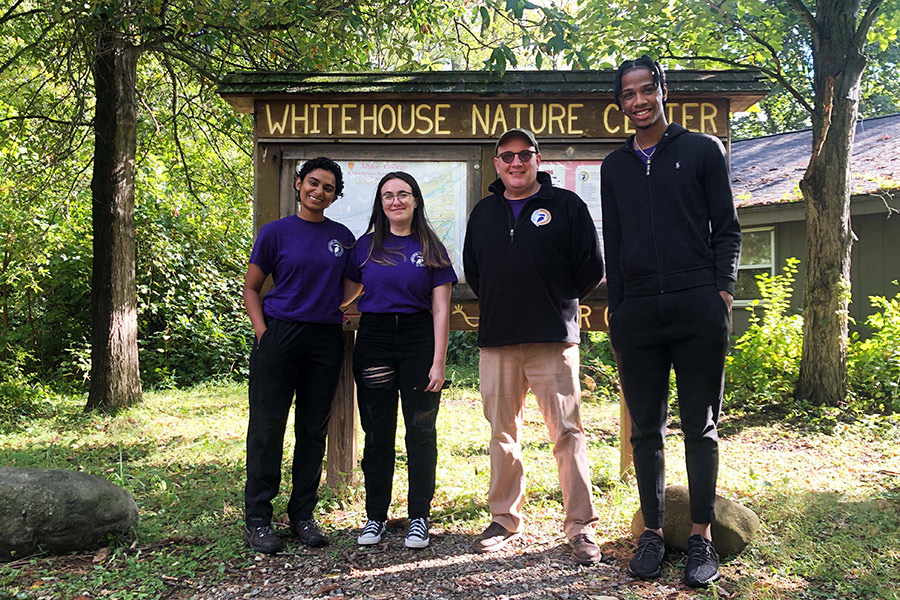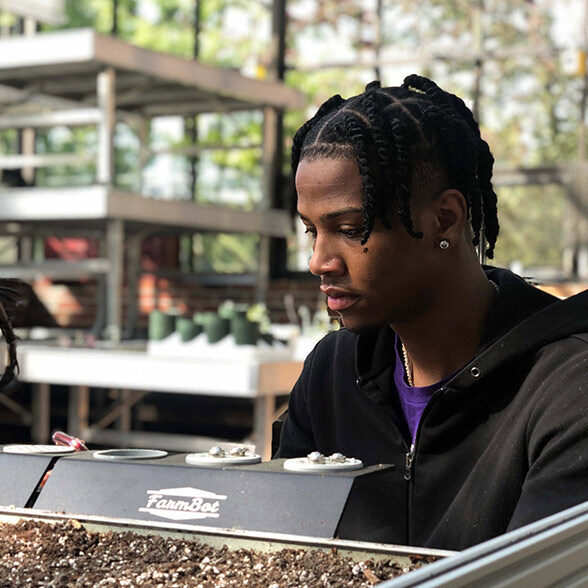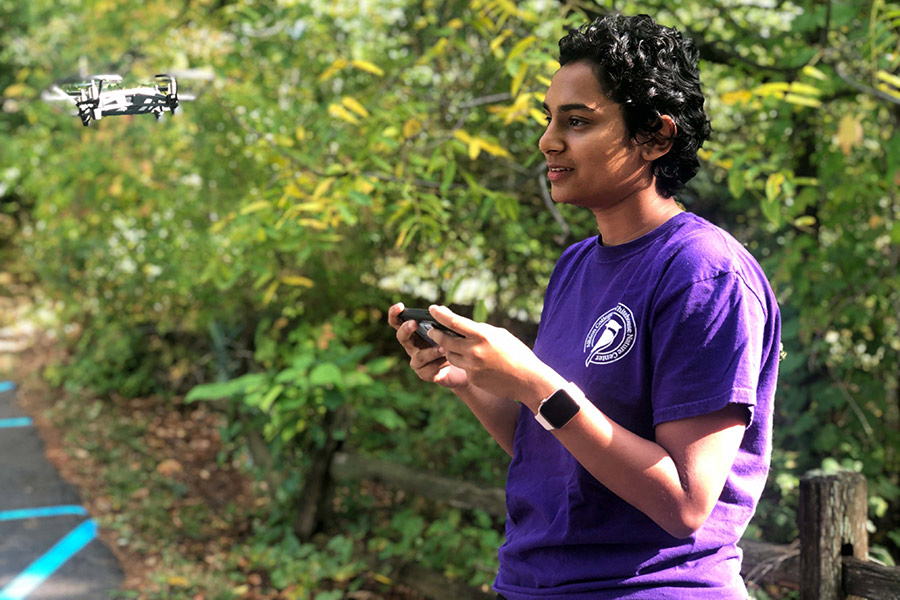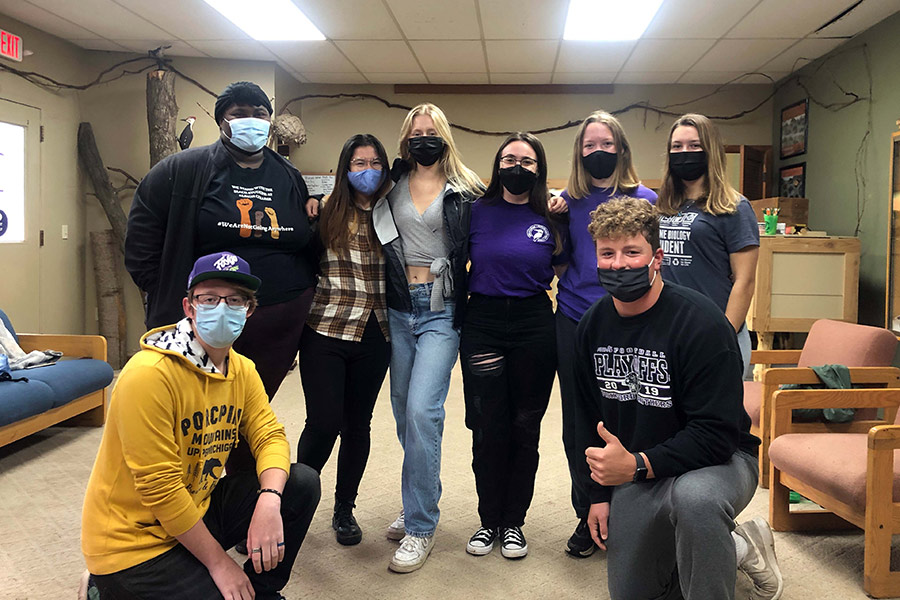Student Employment at Whitehouse Nature Center: Opportunities Abound
Accompanying a large increase in the number of student workers is the creation of five distinct career tracks for more focused experiential learning.
September 27, 2021
By Ariel Berry
Working at the Whitehouse Nature Center provides unique opportunities for a college student.
“I like being with the animals,” says student employee Mikayla Armour, ’24, adding that working with exotics was new to her. “This is my first time holding a turtle, snakes, a lizard, all of that,” she says. Armour came to the Nature Center with anxiety about working with the animals, but has blossomed into an expert handler.
There are many more opportunities at Whitehouse Nature Center. Director Jason Raddatz, ’91, plans to hire more than 90 students this year, including the 35 students who are continuing from last year.
When you walk into the Nature Center, you’d better watch your step. As you walk through the door, a turtle just might amble around the corner. It’s Red, a large red-eared slider. She joins a map turtle, Queen T, in the center of the room. The turtles, Raddatz says, are often loose.
“We let them out for about two hours a day. It’s really important for them to be socialized so that they don’t bite,” Raddatz says. While all of the animals tolerate being held, some of them even enjoy it.
The most unexpected cuddler of the group is Nala, the spotted salamander. Armour says that Nala is her favorite, because she’s “just chill.” Nala, she says, likes to snuggle in her pocket when she’s sitting on the couch. “She likes the dark space, dark and warm,” Armour says.
This is the second year Armour has worked at the Nature Center. “It’s a great place to be working at. It’s different,” she says. Armour is an education major and says she enjoys working with the children who visit the Center on class trips.
Rodney Mitchell, ’24, another returning worker, says his favorite thing about working at the Nature Center is recharging away from technology. “As a college student, I can admit that I spend too much time in front of a screen,” he says. “At the Nature Center, I have the ability to free myself from the technological world and indulge in the real world. The Nature Center provides opportunity for personal growth, while also allowing me to influence the lives of others.”
Mitchell says he knew he wanted to apply for a position after reading the Nature Center’s mission statement. The Center’s website says it has a commitment “to stimulate awareness and understanding of our natural environments among college, school, community, and other groups of all ages.” Mitchell says after reading the statement he “immediately saw an opportunity to make an impact. The Nature Center contributes so much to the community and I wanted to be a part of that.”
Working as a Team
The Center is certainly an unusual work location for a campus job. “My understanding is that the reason why we’re able to attract so many student workers is just the environment down here,” Raddatz says. “This is a really unique environment as far as on-campus jobs go. I tell the students when they’re hired that I have high expectations of professionalism, courteousness, and supportiveness. We’re a team. We work as a team.”
Raddatz adds that his children often come to the Center, and he hires students whom he feels comfortable adding to his family.
Another draw is that Nature Center student employees can choose from five career tracks: Environmental Education, Animal Well-Being and Enrichment, Habitat Restoration, Sustainable Agricultural Entrepreneurship, and Inclusive Social Outreach. As a result, Nature Center jobs attract students across a variety of majors.
One of the things students get experience with is drones. “I enjoy research and technology,” says Tanya Jagdish, ’22, a returning student worker. “I started working with Lee Sprague, a Potawatomi tribe leader, on wild rice restoration and education. In the process, I learned a lot about traditional ricing methods and used my drone piloting skills to map the wild rice beds along the Kalamazoo River.”
Using technology at the Nature Center is not only fun, but useful, too.
Healthy Living
Whitehouse Nature Center also has become more popular with Albion community members due to the COVID-19 pandemic. The Center provides a place to safely socialize outdoors. Last year several professors even held classes there. The pandemic hasn’t actually changed much of the Nature Center’s operations, according to Raddatz. That said, other than donning masks, COVID did lead to one noticeable change—the trails were widened to enable greater social distancing for hikers.
Being outdoors has always been a healthy option for workers and visitors, even before the pandemic. Mitchell says he is double majoring in psychology and nursing with a pre-med concentration and plans to work in child and adolescent psychiatry. Drawing from his medical studies, Mitchell points out that there are health benefits to spending time outside, away from devices and breathing fresh air. “Connecting with nature enables us to connect with ourselves, which naturally extends to the people around us, creating a healthier environment mentally and physically,” he says.
“I love being outdoors,” says Jagdish, “so the first few months I mainly worked on trail maintenance. I would spend most days on the trail clearing out branches, mowing, and weeding the farm.” She says she enjoyed the freedom and variety available to her at the Nature Center. “I love all the diversity of opportunities one has at the Whitehouse Nature Center,” she says. “There is something for everyone to do.”
One thing is clear: students have a lot of options at the Nature Center. “I think that we’ve really scratched the surface of opportunities for student employment down here,” Raddatz says. He explains that before last year, he would hire only a handful of students, who would just complete routine maintenance, until President Mathew Johnson posed the question, “What would you do with 50 students?” Raddatz came away from that conversation with a new idea of what the Nature Center could be.
Career Opportunities
Following his meeting with the president, Raddatz has had a conversation with each student he hires to talk about the student’s career goals and how the Nature Center can provide the experience they need. The work is now more rewarding for students.
Jagdish, who is double-majoring in biology and mathematics, says her employment experience at the Nature Center will help her in her future career. “I want to go into the international climate-change policy sphere and work on translating research into effective policies. I am very passionate about bringing frameworks of ethics and justice into the climate-change conversation,” she says. “My work at the Nature Center has taught me how to take on a leadership role and has also given me the opportunity to work directly with Indigenous peoples here in Michigan. This has enriched my personal experience and changed the way I think about environmental justice. My work at the Nature Center has also helped me become a better science communicator.”
The large number of student employees also means that students can work manageable hours in order to focus on their classes—because academics, Raddatz says, are the most important thing. The Nature Center is there to help guide students toward their future careers in a way that doesn’t interfere with their studies.
Enisa Muhaxhiri, ’22, a biology and international studies major who began working at the Nature Center last year, says Raddatz “makes working there easier with how flexible he is and how much he actually cares about all assistants.” She adds that she loves working at the Center because of “how calm it is. It is definitely the place where you go and work and you simply forget what time it is, and you only realize how quickly time has passed after you leave.” Muhaxhiri says she worked at a similar job in her home country of Kosovo, and knew she wanted to continue to work in nature.
The Whitehouse Nature Center offers a lot to attract students, either as visitors or employees. “You have 140 acres and 5.2 miles of trail, a fully active student farm, a rich and engaging social media presence, and an opportunity to use technology to change lives,” Raddatz says. “I have the best job on campus.”



